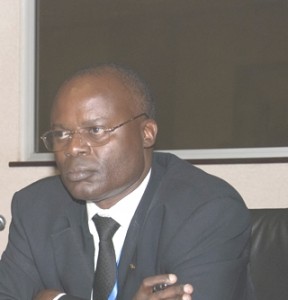Central bank leaves base rate unchanged at 9.5%
December 18—With the festive season spending clearly in mind, the Bank of Uganda (BoU) Monetary Policy Committee has decided to err on the side of caution and maintain the Central Bank Rate (CBR) at 9.5% despite falling inflation figures during the past two months. There are also concerns about the seasonal dry spell in January that usually push food prices up.

Dr. Kasekende said although near-term inflation is subdued, there are upside risks to this outlook taking into account food prices and the exchange rate.
The Annual Headline inflation fell from 4.8% registered in October to 4% in November, but core inflation, on which the BoU partially bases its decisions on the CBR, dipped to 3.3% from 3.5 during the same period.
Presenting the latest policy statement, Dr. Louis Kasekende (right), the Deputy BoU Governor said, “The near-term inflation outlook remains subdued, but core inflation is projected to pick up in financial year 2018/19 to around 5 percent as spare capacity in the economy is reduced. Nonetheless, there are upside risks to this outlook, including the future direction of food crop prices and the path of the exchange rate with the latter contingent on the external environment.”
He said, “Based on this outlook for inflation and economic activity, together with an expansionary fiscal policy in FY2017/18 and the evolution of the risks and uncertainties, Bank of Uganda judges the current stance of the Monetary Policy remains appropriate. The Bank of Uganda will therefore maintain the Central Bank Rate at 9.5%. The band on the CBR will be maintained at +/-3 percentage points and the margin on the rediscount rate at four percentage points on the CBR.”
BoU said the rediscount rate and the bank rate will also be maintained at 13.5% and 14.5% respectively. The continued large allocations towards public investment, growth in consumption and a falling CBR compared to this time last year, point to a GDP growth rate of 5% for FY2017/18.
However, Kasekende said, “Although BoU has maintained the CBR slightly down and the borrowing rates in banks have also come down, the cost of credit is still high and dormant loans across banks are also a bit high. If the manufacturing sector is to catch up, we will need to give affordable long term loans.”

 African Heads of state head to South Korea next week for Summit talks
African Heads of state head to South Korea next week for Summit talks
 Trading leads as main source of income for Ugandans
Trading leads as main source of income for Ugandans
 New leadership for bankers’ umbrella as total assets top $12 billion
New leadership for bankers’ umbrella as total assets top $12 billion
 Brussels Airlines to announce Nairobi service
Brussels Airlines to announce Nairobi service
 SITA promises enhanced travel experience after Materna acquisition
SITA promises enhanced travel experience after Materna acquisition
 Saudia’s 105 aircraft order stretches A320neo lead over rival Max
Saudia’s 105 aircraft order stretches A320neo lead over rival Max
